Below is a selection of recent book publications. For an overview of all VISU publications, click here.
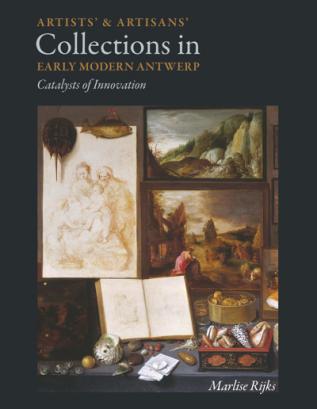
ARTISTS’ AND ARTISANS’ COLLECTIONS IN EARLY MODERN ANTWERP
Catalysts of Innovation
Turnhout: Harvey Miller Publishers, 2022
Paintings, drawings, prints, maps, jewels, gems, statuettes, medals, exotica, antiquities, dried animals, shells, corals, and scientific instruments. All these objects and more were on display in collectors’ cabinets in Early Modern Antwerp. This book tells the story of the collections of artists and artisans, who stood at the centre of and shaped the city’s cultural life. In their double roles as maker-collectors, they put a strong mark on the culture of collecting.
The culture of collecting was inextricably linked to changing conceptions of the material world, which went hand in hand with the emergence of new pictorial genres and the increasing dominance of forms of knowledge based on objects and material evidence. This book traces the important role of Antwerp artists and artisans in this culture of art and knowledge. It is a story about friendship and networks; about new forms of connoisseurship; and about innovation and appreciation.
More info: Brepols
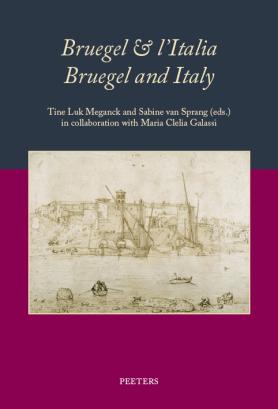
BRUEGEL & L'ITALIA
Proceedings of the International Conference held in the Academia Belgica in Rome, 26-28 September 2019
Tine Meganck and Sabine van Sprang (eds.) in collaboration with Maria Clelia Galassi
Leuven: Peeters Publishers, 2023
Pieter Bruegel the Elder is best known for his peasant and winter scenes, archetypal images of the Low Countries, but his masterpieces always manage to transcend the local. A defining element in his hybrid landscapes are the Alpine rock formations he observed on his way to or return from Italy. Bruegel travelled to the peninsula around 1552, and his sojourn lasted about two years. Though remarkably little of his artistic production in Italy has been preserved, later compositions demonstrate that Bruegel must have journeyed to Rome, and then as far as Naples and Messina.
The purpose of this book is to reassess Bruegel’s encounter with Italy within a broad cultural-historical context and in light of recent scholarship. Communication between Italy and the Low Countries was intense during Bruegel’s time, as were artistic, political, and economic relations. While Italo-Netherlandish ties interconnected Bruegel’s world on multiple levels, Bruegel’s relationship with Italy has mostly been viewed from the perspective of his individual travels. It has often been observed that, unlike many of his fellow artist-travellers, no copies after antique or modern Italian artworks by his hand are known, and that the impact of Bruegel’s encounter with Italy is not immediately evident from his work. Bruegel and Italy/Bruegel e l’Italia rephrases this question: Why, then, Bruegel did travel to Italy? To formulate potential answers, its authors look not only at the master and his work but also consider the cultural and artistic exchange between Italy and the Low Countries before, during, and following Bruegel’s Italian travels. In doing so, they trace the conditions, traditions, and networks that shaped and motivated Bruegel’s dialogue with Italy, opening new avenues in the study of this notoriously under-documented master.
More info: Peeters Publishers
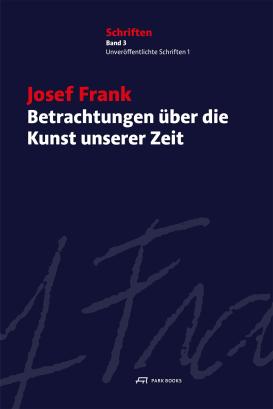
JOSEF FRANK
Betrachtungen über die Kunst unserer Zeit
Caterina Cardamone (ed), Tano Bojankin, Hermann Czech, Claudia Mazanek, Christopher Long
Zürich: Park Books, 2023
Der österreichisch-schwedische Architekt Josef Frank (1885–1967) war nicht nur ein erstklassiger Architekt, Designer und Innenarchitekt, sondern auch ein ausgezeichneter und einflussreicher Schreiber. Den Auftakt macht der vorliegende Band mit Josef Franks Auseinandersetzung mit der Kunst der Moderne. Die Betrachtungen über die Kunst unserer Zeit sind Josef Franks bislang unveröffentlichte finale Analyse der kulturellen Entwicklungen seit dem Fin de Siècle. Kunsthandwerk und künstlerisches Schaffen stehen im Widerstreit und werden gefügig gemacht von totalitären und diktatorischen Strömungen in Europa, die in den Zweiten Weltkrieg münden. Auch auf die USA, wo Frank lehrend und schreibend im New Yorker Exil lebt, greifen bedenkliche Tendenzen über. Der Text Zu Mondrian, ein ‘Leserbrief’, den Frank 1945 anlässlich von dessen grosser Retrospektive im MoMA verfasste, veranschaulicht exemplarisch seine Bedenken gegenüber der Entwicklung der Moderne.
More info: Park Books
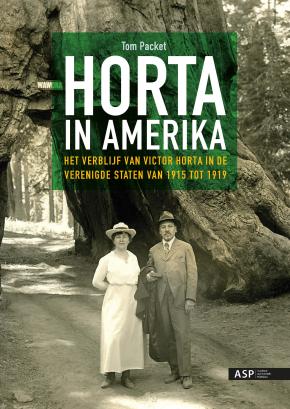
HORTA IN AMERIKA
Het verblijf van Victor Horta in de Verenigde Staten van 1915 tot 1919
Brussel: Academic & Scientific Publishers, 2021
De Eerste Wereldoorlog heeft net als voor veel andere Belgen verregaande gevolgen voor architect Victor Horta (1861-1947). Vanaf 1915 leeft hij in ballingschap, eerst in Londen en daarna in de Verenigde Staten. Daar geeft Horta gedurende drie jaar talloze lezingen in alle uithoeken van het land. Voor volle aula’s en in de woonkamers van steenrijke Amerikanen klaagt hij de wandaden en verwoestingen in poor little Belgium aan. Tegelijk onderzoekt hij hoe de Amerikaanse wolkenkrabbers, gestandaardiseerde woningen en ingenieuze stedenbouw als model kunnen dienen voor een modern, naoorlogs België.
Horta in Amerika biedt voor het eerst een nauwgezette studie van de jaren 1915-1919 in Victor Horta’s leven. Hieruit blijkt dat zijn verblijf in de Verenigde Staten geen alledaags avontuur was, maar een bijzonder relevant verhaal over oorlog en vluchten, verwoesting en wederopbouw, politieke propaganda en culturele uitwisseling - een verhaal dat bovendien essentieel is om Horta’s naoorlogse oeuvre te begrijpen.
Meer info: Academic & Scientific Publishers (ASP)
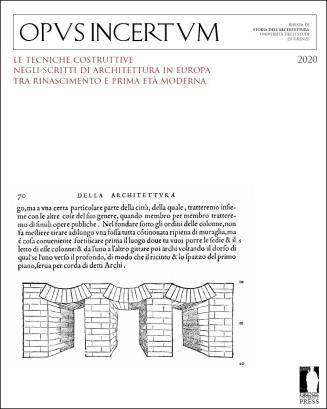
Construction Techniques and Writings on Architecture in Renaissance and Early Modern Europe
Le tecniche costruttive negli scritti di architettura in Europa tra Rinascimento e prima Età Moderna
Caterina Cardamone, Pieter Martens (eds.)
Florence: Firenze University Press, 2020
This thematic issue of Opus Incertum explores the complex relationship between construction practices and architectural writings in early modern Europe. Through selected case studies from Italy, France, Portugal and the Low Countries, it considers how allegedly oral building traditions were confronted with writing, how they adapted their time-honoured methods to theoretical frameworks, and how they used drawing in support of writing for the communication of technical know-how. Various texts on building materials and construction methods are examined to assess why and how they transmitted technical knowledge and how they related to actual building practice; the literary and rhetorical aspects of technical passages on construction are analysed to illuminate their role within the architectural treatise as a whole; and translations and adaptations of internationally circulating texts on construction are looked at to see if and how these were adjusted to local circumstances.
More info: Firenze University Press
Available in Open Access: Download PDF
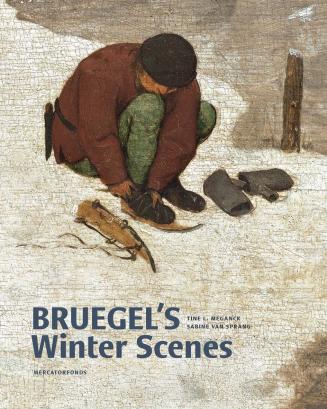
BRUEGEL'S WINTER SCENES
Historians and Art Historians in Dialogue
Tine Meganck, Sabine van Sprang (eds.)
Brussels-London: Mercatorfonds/Yale University Press, 2018
This focused volume presents a deep exploration and new interpretations of the winter paintings of Pieter Bruegel the Elder (ca. 1525–1569). By applying new methodological approaches and interdisciplinary research to these masterpieces of Flemish Renaissance art, including Winter Landscape with Skaters and Bird Trap (1565) and The Census at Bethlehem (1566), both at the Royal Museums of Fine Arts of Belgium, the book offers an enhanced understanding of the painter’s relationship to his time and the extent to which his winter landscapes were meant to reflect real-life situations. After tracing how these paintings have been understood over time, the essays propose new insights into such issues as whether Bruegel depicts the plight of the local populace during winter and whether The Census at Bethlehem challenges or reaffirms central power structures. Abundantly illustrated, Bruegel’s Winter Scenes is both a thorough examination and a celebration of these widely admired images.
More info: Yale University Press
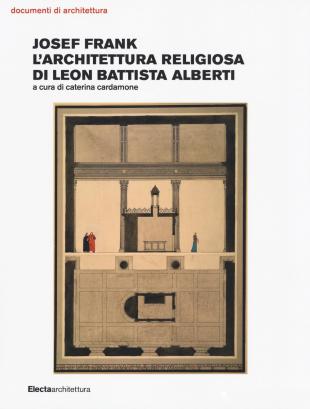
JOSEF FRANK
L’architettura religiosa di Leon Battista Alberti
Il volume, edito per la collana Documenti di Architettura, indaga il valore della critica di Josef Frank verso la tradizione rinascimentale italiana per la definizione di una specifica idea di moderno.
Classe 1885, viennese di Baden, Josef Frank è forse – insieme ad Adolf Loos – l’architetto e il teorico che maggiormente contribuisce alla ricchezza e alla complessità del novecento architettonico viennese. Dopo il viaggio di sette mesi in Italia sulle orme di Alberti, tra Firenze, Mantova e Rimini, nel 1910 discute la tesi di dottorato sull’architettura religiosa albertiana – pubblicata per la prima volta in traduzione italiana in questo volume – che si rivela un documento fondamentale nel contesto della produzione teorica di Frank e della definizione del moderno.Come Alberti aveva educato il suo occhio osservando le rovine di Roma, Frank ha inseguito con vitale fantasia le tracce che Alberti ha lasciato: nella convinzione di una continuità, dell’appartenenza a una tradizione – una convinzione largamente condivisa in ambiente viennese – Josef Frank ricerca nel rinascimento non nitidi canoni formali, ma la varietà e la moderazione che definiscono un antropocentrismo sensibile.Il libro, con i testi di Federico Bucci, Caterina Cardamone, Francesco Dal Co, è corredato dalle riproduzioni delle tavole realizzate ad acquerello, inchiostro e matita da Josef Frank per illustrare la tesi di dottorato.Il volume è stato realizzato in occasione della mostra Josef Frank interprete di Leon Battista Alberti, curata da Caterina Cardamone e Francesco Dal Co, inaugurata alla Casa del Mantegna di Mantova il 9 maggio 2018 nell’ambito della rassegna Mantovarchitettura, organizzata dal Polo territoriale di Mantova del Politecnico di Milano.
More info: Electa
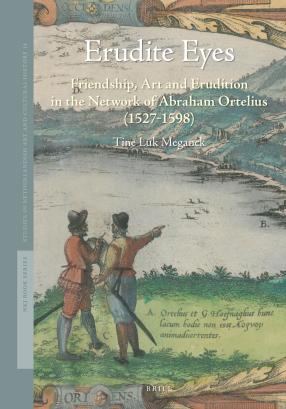
ERUDITE EYES
Friendship, Art and Erudition in the Network of Abraham Ortelius (1527-1598)
Leiden: Brill, 2017
Erudite Eyes explores the network of the Antwerp cartographer Abraham Ortelius (1527-1598), a veritable trading zone of art and erudition. Populated by such luminaries as Pieter Bruegel, Joris Hoefnagel, Justus Lipsius and Benedictus Arias Montanus, among others, this vibrant antiquarian culture yielded new knowledge about local antiquities and distant civilizations, and offered a framework for articulating art and artistic practice. These fruitful exchanges, undertaken in a spirit of friendship and collaboration, are all the more astonishing when seen against the backdrop of the ongoing wars. Based on a close reading of early modern letters, alba amicorum, printed books, manuscripts and artworks, this book situates Netherlandish art and culture between Bruegel and Rubens in a European perspective.
More info: Brill
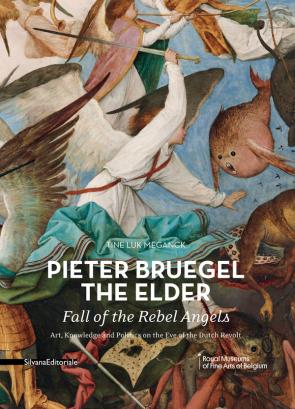
PIETER BRUEGEL THE ELDER
Fall of the Rebel Angels
Art, Knowledge and Politics on the Eve of the Dutch revolt
Milano: Silvana Editoriale, 2014
Pieter Bruegel the Elder, Fall of the Rebel Angels is the first comprehensive book on one of the most cherished masterpieces of the Royal Museums of Fine Arts of Belgium in Brussels. It argues that with the Fall of the Rebel Angels (1562), Pieter Bruegel (d. 1569) turned a traditional devotional theme into an innovative commentary on his own time, and situates the painting within the early modern cultures of knowledge and collecting. More particularly, it suggests that many of the hybrid falling angels are carefully composed of naturalia and artificialia, as collected in art and curiosity cabinets of the time. Bruegel’s noted emulation of Hieronymus Bosch was only part of his wider interest in collecting, inspecting and imitating the artistic and natural world around him. His interests prompt an examination of the world when he painted the Fall of the Rebel Angels: locally, in the urban and courtly centers of Antwerp and Brussels on the eve of the Dutch Revolt, and globally, as the discovery of the New World irreversibly transformed the European perception of art and nature. Painted as a cautionary tale of hubris and pride, Bruegel presents the Fall of the Rebel Angels as a meditation on the dangers and potential of man’s pursuit of art, knowledge and politics, a universal theme that has lost nothing of its power today.
More info: Silvana Editoriale
